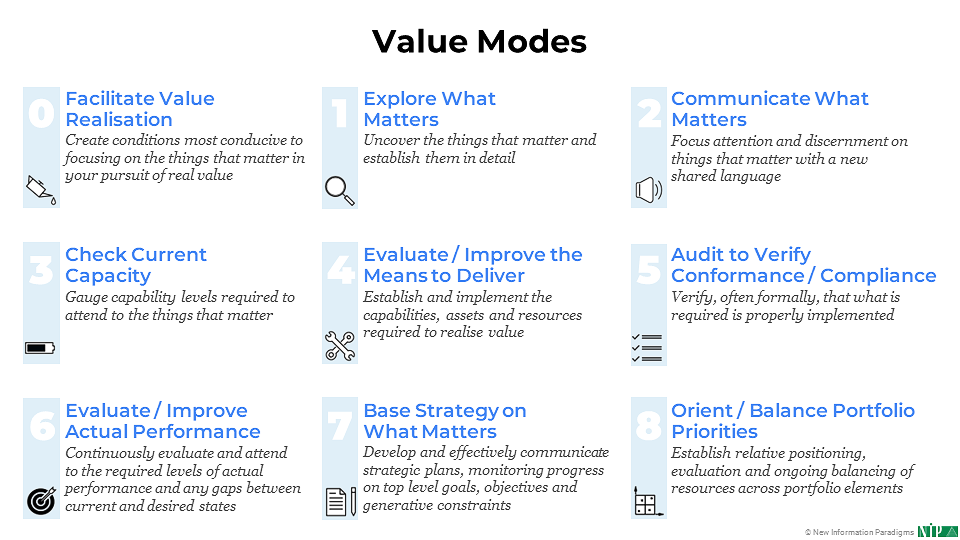Value Management: Value Modes
Value Modes are nine recognisably distinct focuses, or mindsets, that we have factored-out to clarify how Value is conceived of and looked at.
These varying mindsets profoundly affect the kinds of activity undertaken and how it is done, the goals of those activities, who is involved and so on – all of which guides how ARC Diagnostics are used:

Without the separation and clarity of Value Modes, the differences that make a difference get overlooked – frequently with disastrous results.
This is often compounded when people try to operate in more than one Value Mode at once (e.g. attempting to combine Means and Audit, where one is developmental and one checks for non-compliance, which are directly opposed).
How Value Modes Interact with Each Other
Every situation has a surrounding Strategy (Value Mode 7) that contextualises, shapes and is shaped by the activity within it – i.e. Value Exploration, Communication, Capacity, Means, Audit and Performance (Value Modes 1-6) – and which can learn from, and influence, Strategy in other situations.
Situations in turn have a Portfolio dimension (Value Mode 8), whereby a portfolio approach can be used:
- Within a situation, e.g. to organise and make sense of multiple actions, relationships, etc.
- Across multiple situations, e.g. to establish relative Value between them and priorities across them.
All of this takes place within the enabling context – or on top of the foundation – of Value Mode 0: Value Facilitation, which establishes conditions conducive to realising Value.
However, just as Strategy both shapes and is shaped by activity within the situation, so these conditions evolve over time as things change.
Activity within the situation is therefore in a constant “dialogue” with its Strategy, and Strategy is in a constant “dialogue” with the organisation – the key to achieving Alignment, Resilience and Coherence both within and across situations.
Progressing with Value Modes
The ultimate aim is to cycle round and manage the interactivity between all of the Value Modes in an appropriate balance, and this is guided by clear logical and overlapping “sequences” – or Value Journeys – that straddle Value Modes, where the destination of one is particularly strongly linked to the starting-point of another, e.g.:
- Overarching strategy and resource management: Exploration + Strategy → Strategy → Portfolio
- “Translating” strategy through to results: Exploration + Strategy → Communication → Capacity → Means → Performance
- Operational excellence: Capacity → Means → Audit
- etc.
However, Value Modes are also networked, affecting and being affected by each other, so there isn’t just one linear route through them – e.g. poor Performance may reflect changes in Value that Exploration needs to explore – and Value is constantly changing, which means that Value realisation is a continuous and iterative process.
Featured content:
Articles related to Value Modes:
Mastering Complexity: Part 3
Mastering Complexity: Part 3: Harnessing Complexity Introduction Part 1: What Complexity Is Part 2: Complex vs Complicated Part 3: Harnessing Complexity We began this series (Part 1) by establishing that today’s global business environment is highly Complex, but saw last time (Part 2) how accepted “wisdom” instead persists in treating…

